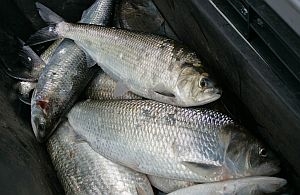
(Host) The mystique of the spawning salmon running upstream has intrigued many.
But there’s another migrating fish, outside of the limelight, that also has a passionate following. It’s the "American Shad."
As part of a collaboration of Northeast public radio stations, WFCR’s Tina Antolini reports that the number of shad is declining in many rivers.
(Antolini) By dawn on a breezy Sunday, more than a dozen fishermen are staking out prime shad-catching real estate along the edge of the Connecticut River in Holyoke, Massachusetts. A bunch of men- middle-aged and older– are wading in the water, their lines cast, hoping for a big fish– something over 5 pounds. In the meantime, they heckle one another.
(Garber) "Don’t lose that fish Lou, Lou– you can land that… A big one for him is about a pound and a quarter, let’s say."
(Antolini) Michael Garber only gets a chance to rib his friends for the few weeks the shad are running.
(Garber) "It’s part of rite spring in a sense– you know, I know once I start to see the forsythia, and especially lilacs, the shad are in the river."
(Antolini) Like salmon, shad live in the ocean, and migrate hundreds of miles back up to the freshwater rivers they were born in to spawn. Besides the Connecticut, they come up the Kennebec in Maine, the Merrimack in New Hampshire, and the Delaware in New York. Shad play a key role towards the bottom of the food chain… But, they are notorious fighters…
(Downey) "Oh– he’s a strong one, ain’t he! He does not like to be hooked!"
(Antolini) Sean Downey, who’s in his forties, loves the battle… He says you have to wrestle with even the little ones.
(Downey) "They jump out of the water like a salmon– they’ll rip 50 yards of line on ya, every once in a while, just tear it right off your reel. And it’s just– bye, see ya. I’m an angry shad, bye."
(Antolini) Downey and the others love these sleek, silvery fish, but they don’t know some things about them, that used to be common knowledge … like how to fillet a shad… The fish is packed so full of bones, some say it’s like encountering two skeletons in one fish. And so, these guys almost always throw them back; they rarely eat them. But some shad experts say they don’t know what they’re missing:
(Kynard) "The scientific name of shad is Alosa Sapidissima. And Sapidissima means most delicious. That’s why it was named most delicious is because they are just amazingly good."
(Antolini) That’s 70-year-old Boyd Kynard, a shad fisherman and a biologist with the federal Conte Anadramous Fish Lab… He likes to smoke shad, but he says not many people know how to do that anymore, either. There once were plenty of folks who knew how to cook the fish… According to some accounts, during the Revolutionary war, shad saved George Washington’s troops, who were on the verge of starvation.
(Kynard) "Those were Connecticut River shad, too… Barrels and barrels of ‘em that were shipped down to Valley Forge."
(Antolini) This time of year, you can still find shad festivals on rivers up and down the Atlantic Coast. But some are almost without the actual fish. There aren’t any to eat at the shad festival in Windsor, Connecticut… or at one on the Hudson River, that changed its name to the "Springtide Festival" because of the lack of shad. So it’s not just the old-time fishermen who’s numbers are diminishing… the number of shad is in decline, too.
At the Holyoke Dam, an alarm goes off to let a crowd of spectators know that the fish lift– a giant, water-filled elevator– is about to rise… Dams on every river in the region cause big problems for shad and other migrating fish, stopping them as they swim upriver. Fishlifts like this were supposed to be a solution. But the numbers here have dropped in recent years– from a high of 720,000 shad in 1992, to only a 150,000 last year.
Boyd Kynard says nobody’s sure exactly why, though there are theories… One is an explosion in the number of striped bass that eat young shad like a snack. Another is that shad may be hit by shifts in the ocean’s temperature, due to climate change.
(Kynard) "We know that the sites that they go to feed are very much temperature related and so that may have effected survival of some of these fish."
(Antolini) But so far, Kynard says, no one is looking at this in a comprehensive way.
(Kynard) "To study this kind of thing means you have to study fish at sea– that’s very expensive. And if it were Atlantic salmon? Maybe they would find some money. But for shad– hasn’t been found yet."
(Antolini) Kynard says it’s something we may have to invest in for the shad to keeping running in droves each spring.
For VPR News, I’m Tina Antolini.